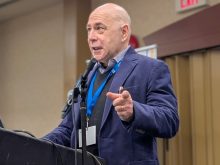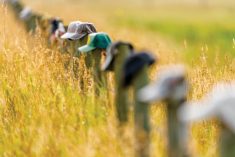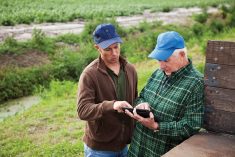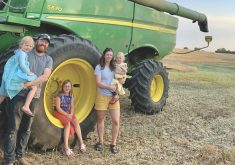The Prairie Farms feature is an ongoing series that highlights western Canadian producers and their farm operations. These producer and farm profiles will share the strategies, tips and experiences that have helped Prairie farmers be successful. Along with crop production strategies, this Q-and-A series will look at the personalities and lifestyles of farmers across Western Canada.
For this farm profile, Braden Hursh spoke with Manitoba grain farmer Robert Misko and his daughter Courtney.
Where is your farm operation located?
Read Also

In times of mandatory joy, try to find contentment
If we’re not feeling the joy at a time of year that seems to insist on over-the-top moments of happiness, we can allow ourselves to just try for fulfilled or content, farm family coach Kalynn Spain suggests.
A: We are located between Roblin and Grandview in the Parkland Region of Manitoba.
How long has your family been farming in the area?
A: Mom and Dad moved to the farm from Brandon, Man., in 1976 and the family has farmed the area ever since.

How much land do you farm?
A: We seed 6,500 acres and then we do another 2,500 acres of seeding and custom work for our neighbour.
What is the soil type found on the majority of your land?
A: We are in a black soil zone, so mostly a clay loam.
Who is involved in the farm operation?
A: We are about as “family farm” as you can get. There’s myself (Robert) and my wife, Leifa. My parents still live on the farm, but they are basically retired now. Three of my kids are actively involved in our day-to-day operation: Courtney (31), Robbie (26) and Brittany (33). We also have a part-time hired hand to help with seeding, harvest and driving truck.
Leifa and Brittany basically do all of the seeding, while Robbie and I do whatever else needs doing like spraying and hauling seed and fertilizer. Courtney is an agrologist and does rolling, hauling grain and whatever else needs to be done.
Education and skills are essential in running a farming operation. Do any of the people involved in your operation have additional training or knowledge?
A: Courtney received a Bachelor of Science degree with a major in agronomy from the University of Saskatchewan and is an agrologist. Brittany is a CPA (chartered professional accountant) and handles our finances. There is also another Misko daughter who is a medical doctor and not involved in the farming operation.

For Courtney, how has being an agrologist changed your perspective of working on the family farm?
A: I now have a better understanding of chemicals, how crops grow and what different diseases look like and how we can help things to get better.
What are the main crops grown at your farm?
A: Our major inputs are spring wheat, canola and peas.
What has been your best crop historically?
A: It’s really a toss-up. Lately peas have been pretty good, but for straight dollars to acres, canola is probably our No. 1 in regard to potential. Each of our three crops have been pretty close over the long term.
How do you plan your crop rotation?
A: We try to keep our peas on a four-year rotation and then our wheat and canola will be a two-year or a three-year (rotation) depending on the situation. But we have everything planned out for the next five years just to ensure everything is how we want it to be.
What are some techniques and strategies you use on the farm?
A: We have been minimum till for a long time now. We had tried zero till but found that our land was just a bit too heavy for that and ran into too many issues. Our land is typically too wet, not too dry, so springs could become challenging. We knife in anhydrous ammonia in the fall, which gives us just enough soil disturbance, a little black on top, to help the ground warm up and dry in the spring. We seed with a 3720 Bourgault drill and we really aim for a bare minimum of disturbance and have been doing it this way for 12-14 years.
We have been doing soil tests on each of our fields for years and we do all of our fertilizing in the fall, so we know exactly what we need to put down for every single acre we farm. We also do a lot of pre-emergence chemicals, and we are committed to it.
What are some strategies you have tried but weren’t happy with?
A: We have tried variable rate and prescription fertilizers, but we haven’t really seen additional value from it. There’s a lot of hype around it and a lot of people who will charge you a lot of money for it, but it hasn’t been a sustainable practice for us.
Mother Nature has more to do with it than we do. Look at this year, we could have done variable rate for every single field but if it doesn’t rain then it won’t make any difference anyway.
What do you seed and harvest with?
A: We run two Bourgault 3720 drills and for combines we have two 8.90 New Hollands. Our neighbour also has a similar combine to ours and we often team up during harvest.

What is a key trait of your farming operation?
A: I have always been a firm believer in knowing the market on an ongoing basis. I know my total cost of production, and I know what I need to be doing to make money on each piece of land. I also believe that you have to sell grain when you are above breaking even. Through effective financial management and keeping an eye on prices on an ongoing basis, we have been able to do very well.
What is your best recent purchase?
A: We bought a grain dryer a few years ago and it has allowed us to get onto a field and combine sooner — we do not have to wait for the grain to be completely dry. This allows us to move the grain soon after combining and gives us peace of mind storing grain during a wet fall, as we can always ensure it is dry for the winter.
Also, Macdon Flex Headers. We have very rolling land, with a few hills, and these headers follow the terrain easily. Broken sickles and guards replacements have been reduced since using them.
What are the strengths of your farming operation?
A: I never went to post-secondary school after high school. After grade 12, I started farming with my dad. My kids have all gone to school and gained valuable skills. It has been all about ongoing succession planning throughout the years, about how to keep the operation running strong.
I don’t like paying someone to do something for my farm. If someone on our farm doesn’t know how to do something, we learn how to do it. There are too many consultants, specialists and market analysts who are only beneficial until the weather changes. We are self-reliant on our farm and that has made us stronger and better at all the different aspects of farming. We have our own construction equipment, good farm equipment, our own agrologist, our own accountant and our own operators. We take pride in our ability to help ourselves.
What advice would you give to other farmers?
A: Know your cost of production. If you don’t know when you are making money and you are debating when to sell, you can’t make an informed decision. I’m a pessimist, so I know that when the prices are right and I am able to make money on my grain, I sell. To make your farm profitable, you need to know your cost of production and make decisions based around that. If you are selling at a profit, then you’ll never go broke.
We think another good piece of advice for young farmers is to get involved within their communities, whether it is a local agricultural board, municipal government or a provincial agricultural group. Their voices are essential in helping their communities and the overall agricultural sector grow. Over the years, Leifa and I have made time to become involved and now the kids are continuing that trend.
What do you do for fun?
A: We travel in the winter. We typically go down to the Caribbean, Dominican Republic or Mexico. We don’t have a lot of time to travel in the summer with how busy we are on the farm. My son, Robbie, really loves scuba diving so we like to go to warm places. We are homebodies in the farm season, but we love to get away in the winter. This winter we are off to the Mayan Riviera.















